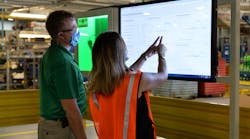How Schneider Electric Knows if a Plant Can Successfully Digitize
For manufacturing digitization to succeed, leaders have to know what they’re going to do with the manufacturing plant data before ever seeing it.
Mauricio Casares, smart factory improvement manager at Schneider Electric’s plant in Lexington, Kentucky, in 2017 was part of a team that developed a robust set of standardized plant digitization tools. The company had long since embraced digitization, but typically on a plant-by-plant, piecemeal basis.
A standardized toolset made a lot more sense than trying to scale those custom systems to multiple, non-digitized plants. However, once Schneider Electric developed the tools, it needed to figure out which of its 35 plants and distribution centers in North America provided the best locations for successful adoptions.
Schneider Electric’s decision-making process for choosing which plants to digitize serves as a roadmap for any manufacturer that wants to embrace IoT-based monitoring systems.
Network infrastructure and ease of IoT system installation were key considerations but what determined the most successful digital evolutions depended on process and people, not technology.
“Target plants should have some sort of a Lean program. If you don’t have a Lean program, it’s difficult to drive digitization on top of nothing," Casares says. This is the first pillar for success.
Go Lean to Embrace Digitization
The introduction of digitization tools at Schneider Electric follows the company’s Lean concepts. The first goals for any new plant-wide IoT system focus on capturing and analyzing data on overall labor efficiency (OLE) and overall equipment efficiency (OEE).
Plants can only take maximum advantage of the data if they already have systems in place to share performance information, like daily meetings to discuss results of previous shifts. It’s also important that candidate plants can map operator competencies like efficiency or defect rates to target the first, most important potential process improvements.
“Start with the basics, in line with your Lean program, and then keep going forward,” Casares adds. Condition monitoring, predictive maintenance and all the other, more advanced systems enabled by IoT architecture come later.
Schneider Electric’s 66-year-old Lexington plant manufactures load centers and safety switches. The plant had a long-established, successful Lean program when the digitization toolset development project began, with manual performance tracking displayed prominently on whiteboards and discussed at regular process improvement meetings. After the digital upgrade, IoT devices replaced manual tracking, and digital dashboards provided real-time analytics.
Other Factors that Support Digitization
The highly networked Lexington plant was in the middle of developing a custom MES system, providing a digital structure on which Casares and his colleagues laid the new toolset.
Installing a brand-new network infrastructure at a plant presents a danger for installing standard digitization tools, Casares says. Plant management can get excited about the possibilities opened up by new servers, cabling and IoT devices and push for pilots that may generate enthusiasm but cannot scale, throwing plants off a digitization plan.
Another factor that favored Lexington: A high degree of automation. Modern production tools more likely support Ethernet connectivity.
“Now, does a plant need to be automated to be digitized? I would say 50/50. Not necessarily. You can have semi-automated equipment, or you can even have manual equipment with the right sensors within the tools so you can start collecting information,” says Casares.
Lexington provided another advantage for developing standardized tools that must account for a wide variety of plants and operations: vertical integration. Stamping, plastic injection molding, electroplating, semi-automated assembly and painting all take place in the same Lexington facility. The Lexington plant offered a robust template to develop a comprehensive digitization toolset applicable to a wide variety of machines.
Vertically integrated plants also make it easier to draw connections in the data between different process steps, to better understand cause and effect. A change to the system at process step A provides greater efficiencies at step B and/or C. Plants don't have to be vertically integrated to successfully digitize, Casares says, but all other things considered equal, a manufacturer may learn more about digitization by working first with these plants.
Creating Plant Digitization Leadership
Simultaneous with technical development of the new toolset, the Lexington plant also made strategic changes to support the project long-term.
The plant chose a ‘smart factory champion’ to shepherd the plant’s transition to the new tools by following a digitization roadmap for the facility, like tracking necessary capital requests for computers or sensors to keep the project on schedule.
“Usually we start with the manufacturing engineers because their role is to make the manufacturing shop floor or the lines more efficient,” says Casares.
“If you’re going to collect information on automated equipment like molding presses or stamping presses, usually you will also have in the facility a more technically oriented maintenance department. These people serve as a resource to that smart factory champion,” Casares adds, for instance to help install IoT sensors on equipment.
The smart factory champion would also take responsibility for coaching other manufacturing engineers in how to use new IoT systems and other smart technologies. In time, the ‘champion’ may evolve into a formal smart factory engineer position (Casares in 2020 joined the Lexington team as the ‘smart factory improvement engineer.’)
Rather than designate someone to handle change management for smart factory programs, plants may want to assign the tasks to a performance leader or whoever leads continuous improvement programs, as digitization systems provide the sort of information that supports successful Kaizens.
“Even if they have the best intentions, it will come to a point where a [performance leader or continuous improvement leader] won’t have the bandwidth to focus on everything [smart factory related],” Casares says.
Casares adds that a plant installing a new digitization system might not create a formal smart factory manager position immediately, however, until plant management understands the bandwidth that position requires.
You May Be a Problem Child for Digitization if…
Only three things make Casares walk away from a plant rather keep trying to get management on board with the standard tools:
· A truly underperforming factory
· When plant management requires changes in the software code before adopting the tools
· If the plant’s homegrown tools are actually better than the standard Schneider Electric toolset (which occurred only once, at the Victoria plant in British Columbia, Canada).
Eleven Schneider Electric plants sent representatives to the Lexington plant during development of the new digital tools and adopted them immediately. Casares says management for half of Schneider Electric’s North American plans were skeptical about the new tools and 10% of the plants were downright uninterested.
“The plants that decided ‘Nope, I’m going to track my production on Excel files, I know how to run my production.‘ They lag behind,” Casares says, adding that most of these plant managers come around once they see the productivity improvements at plants employing the tools.
Encouraging incremental steps versus expecting every plant to adopt the full digitization system helps ease misgivings. Basic tools, like simple IoT devices and data analysis to replace analog record-keeping and Excel spreadsheets, can provide enough benefit to convince plant managers to embrace the entire smart factory program.
Plants that already employ homegrown digitization systems may resist adopting standard toolsets out of concern that new systems might provide lesser results.
“They have their homegrown tools. They have a million different databases, they use Access, SQL, macros with Excel…trying to change the mindset at a plant like that…is where we have failed,” Casares says.
Plants with no digital infrastructure whatsoever also present a significant challenge. It can take two to three years to get these plants up to speed, but installing simple tools to measure OLE and OEE goes very quickly after completing a basic infrastructure.
Advanced Degrees of Digital Success
The Lexington plant, named as a 4th Industrial Revolution Advanced Lighthouse and Sustainability Lighthouse by the World Economic Forum, stands as Schneider Electric’s highest-profile Industry 4.0 success story. A quick list of the plant’s accomplishments:
· An augmented reality advisor system decreased mean repair time by 20%.
· Power monitoring tools led to a 26% energy reduction savings and 30% net CO2 reduction.
· Water resource monitoring led to a 30% reduction in water use.
· SCADA expert software in the paint room reduced downtime by 5%.
Achieving results like these is rarely simple, but the strategy on getting started is. Establish the basics like digitizing OLE and OEE data. Then, take steps into more complicated systems.
“Now, where you have to be strong and try to push back to these plants [new to smart factory tools] is that if you don’t have the basics, don’t ask me for an expensive IoT platform or cloud-based condition monitoring or predictive monitoring. Have the basics. And then we’ll talk on what else can we enable for you,” Casares says.
“You have to follow the path. Otherwise, you will over overwhelm your smart factory champion with all the tools, new tools that he doesn’t understand,” Casares adds.
About the Author
Dennis Scimeca
Dennis Scimeca is a veteran technology journalist with particular experience in vision system technology, machine learning/artificial intelligence, and augmented/mixed/virtual reality (XR), with bylines in consumer, developer, and B2B outlets.
At IndustryWeek, he covers the competitive advantages gained by manufacturers that deploy proven technologies. If you would like to share your story with IndustryWeek, please contact Dennis at [email protected].




